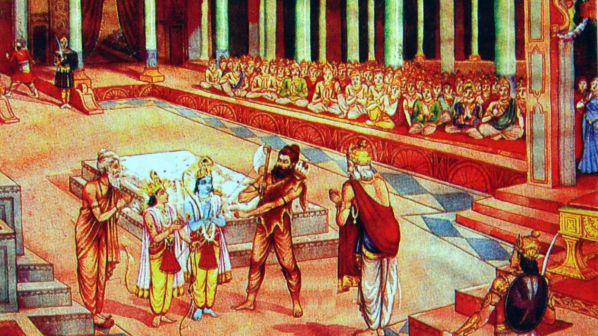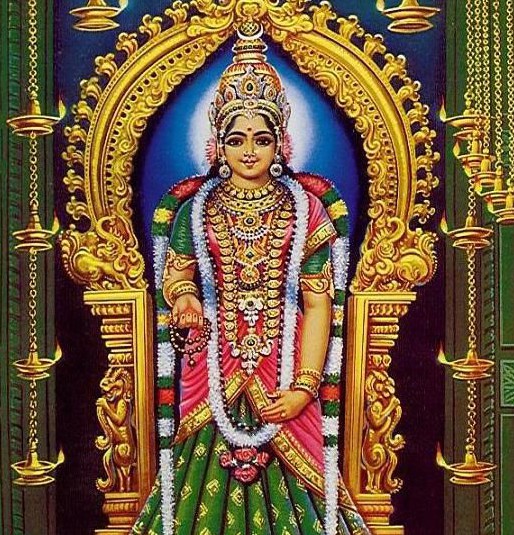No products in the cart.
Bhagwan Parshuram was the Great Grandson of Bhrugu Rishi, after whom the “Bhruguvansh” has been named. Bhrugu’s Son, Richeek, married King Gadhi’s daughter, Satyavati. One day, Satyavati requested Bhrugu for a Son for herself and her mother. Bhrugu prescribed separate regimens for the two ladies in terms of worshipping a particular kind of tree, keeping in mind that Satyavati was married to a Brahmin and Her mother to a Kshatriya. However, the two ladies got confused – Satyavati followed the regimen of her mother and Vice Versa. Consequently, Bhrugu foretold that Satyavati’s son will display Kshatriya traits and her mother’s son will display Brahmin Traits. After some pleading, Satyavati convinced Bhrugu to have this effect, not on her son (Jamadagni) but her Grandson (Parshuram) Jamadagni married Renuka, daughter of King Prasenjit. They had five Sons, Parshuram being the youngest, the others being Rukmvan, Sushen, Vasu and Vishvasu. As Bhrugu had foretold, Parshuram, despite of being born in a Brahmin family, had Kshatriya traits in terms of valour, as was displayed after Haihaya King Sahasrarjuna killed his father Jamadagni.
The Killing of Jamadagni
A Haihaya King Kartavirya Arjuna (Sahasrarjuna – purported to possess a thousand arms) and his army visited Jamadagni, a Brahmin sage, who fed his guest and the whole army with his divine cow Surabhi. The king demanded the magical cow. Jamadagni refused because he needed the cow for his religious ceremonies. King Kartavirya Arjuna (Sahasrarjuna) took the cow forcibly and devastated the ashram. Angered at this, Parshuram killed the king’s entire army and, after cutting each one of his thousand arms, killed the king himself with his axe. As a revenge, the King’s sons killed Jamadagni in Parshuram’s absence.
Furious at his father’s murder, Parshuram killed all sons of Sahasrajuna and their aides. His thirst for revenge unquenched, he went on killing every adult Kshatriya on earth, not once but 21 times, filling five ponds with blood. These are the actions which highlight his warrior characteristics. Ultimately, his grandfather, Richeek Rishi appeared and stopped him. Subsequently, he donated the whole of the earth won from the Kshatriyas to Brahmins. Drona reaped the benefit of this donation by Parashurama; he went to Parashurama and requested for Parashurama’s warfare skills. Parashurama agreed.
Bhagwan Parshuram – Legends
It is said that when Parashurama saved and reclaimed Kerala, he settled Kerala from the retreat of the sea, that was the beginning of the Kollam Era (AD 825) (possibly named after the city Kollam) for the Malayalam Calendar.
According to one legend, Parshuram also went to visit Shiva once but the way was blocked by Ganesha. Parshuram threw the axe at him and Ganesha, knowing it had been given to him by Shiva, allowed it to cut off one of his tusks.
There is an interesting side to Parshuram’s conquest of Kshatriyas. After one his conquests, he returns to Aihole (Badami Taluka, Bagalkot district in Karnataka) which, some say was where he lived. Those who know Aihole would know that the river Malaprabha does a near 180 degree turn there. While Parshuram washed his blood soaked axe upriver, beyond the bend, there were village belles washing clothes downriver. The axe was so bloody that it turned the entire river red. This, the women washing clothes saw and exclaimed “Ai hole!” (Oh, what a river!). The name stuck and the village is now known as Aihole. There is a legend that Nairs (Nagas) of Kerala removed their sacred thread and hide in forest to avoid Parshuram’s revenge against Kshatriyas. Parshuram donated the land to Nambuthiri Brahimns and Nambuthiris denied the Nairs Kshatriya status (though they did Kshatriya duties and almost all the royal houses in Kerala come from them)
Shiva’s Bow

In the Ramayana, Parshuram came to the betrothal ceremony of the seventh Avatar of Lord Vishnu, Rama, to princess Sita. As a test of worthiness the suitors were required to lift and string the bow of Shiva, given to the King Janaka by Parshuram. Rama successfully strung the bow, but in the process it broke in two, producing a tremendous noise that reached the ears of Parshuram.
In one such version, played in ramlilas across India, Bhagwan Parshuram arrived after hearing the sound of the bow of Shiva breaking. The Kshatriyas were afraid to confront the sage, but Sita approached the sage. He blessed her, saying “Saubhagyawati bhavah”, literally meaning “be thou blessed with good luck”. So when he turned to confront Rama, the destroyer of Shiva’s bow, he could not pick up his axe to do so. This was so because, as he blessed Sita with good luck, he could not cause any harm to her husband. At the same time, he recognized Rama for what he truly was, namely, the avatar of Vishnu as his bow fent flying in the hands of Lord Rama.
The Mahabharata
In the Mahabharata, Bhagwan Parshuram was the Guru of the warrior Karna, born to a Kshatriya mother but raised as the son of a charioteer, or lower class of Kshatriyas. Karna came to Parshuram after being rejected from the school of Drona, who taught the five Pandava and one hundred Kauravas princes. Parshuram agreed to teach Karna, believing him to not be of Kshatriya birth [citation needed], and gave him the knowledge of the extremely powerful Brahmastra weapon. But an incident would render the Brahmastra almost useless to Karna.
One day, Parshuram was sleeping with his head resting on Karna’s thigh, when a beetle crawled up and bit Karna’s thigh, boring into it. In spite of the bleeding and the pain, he neither flinched nor uttered a cry so that his teacher could continue his rest. However, the blood trickled down, reaching Parshuram and awakening him. Convinced that only a Kshatriya could have borne such pain in silence and that Karna had therefore lied in order to receive instruction, he cursed Karna that his knowledge of the Brahmastra would fail him when he needed it most. Later, during the Kurukshetra war, Karna had a dream at night when he thought of his guru and asked him to take back the curse he had warranted years back. Parshuram explained that he knew that the day would come; he knew that Karna was a Kshatriya, but deemed him to be a worthy student and instructed him nevertheless. However, the outcome of the war would have left the world in ruins if Duryodhana were to rule, as opposed to Yudhishtra. For that reason, Parshuram requested that Karna accept the curse and fall at the hands of Arjuna, inadvertently saving the world.
Parshuram was the guru of both Bhishma’s (Devavrata) and Dronacharya. Also, the Sudarshan chakra (or Sudarshan Vidya) is said to be given by Bhagwan Parshuram to Krishna.
The Sixth Avatar of Vishnu – Bhagwan Parshuram
![]()
The purpose of the sixth incarnation of Vishnu is considered by religious scholars to be to relieve the earth’s burden by exterminating the sinful, destructive and irreligious monarchs that pillaged its resources, and neglected their duties as kings.
Parshuram is of a martial Shraman ascetic. However, unlike all other avatars, Bhagwan Parshuram still lives on earth, even today. Secondly, he is an Avesha Avatar, a secondary type of Avatar. In such an Avatar, Vishnu does not directly descend as in the case of Rama or Krishna but instead enters the soul of a man with His form. Accordingly, unlike Rama and Krishna, Parshuram is not worshiped. But in South India, at the holy place Pajaka, there exists one major temple commemorating Parshuram.
Parashurama, the creator of the Konkan coast, is also worshiped in a temple at Lote Parshuram in Maharashtra’s Ratnagiri district. The people of the Konkan call their land ‘Parshuram Bhoomi’ or the land of Parshuram in accordance with the legend that the sage reclaimed the land from the sea.
There are several Parshuram temples throughout the western coast of India as well as North India, but especially more in the coastal areas from Bharuch in the West Indian state of Gujarat right up to Kerala, the southern tip of India. One can see a Parshurama Temple with an Agni Mandir in Shivapur, Akkalkot and Khopoli in Maharashtra and Fort Songadh in Gujarat.
Kalki Purana
The Kalki Purana states Parshuram will be the martial guru of Sri Kalki, the 10th and final avatar of Lord Vishnu. It is he who instructs Kalki to perform a long penance to Shiva to receive celestial weaponry.
Parshuram and Temple Deities

In the Kanyakumari Temple in Kanyakumari town, Bhagwan Parshuram installed the Idol made of blue stone. Parshuram installed the idol of Dharma Sastha (Ayyappa) on the peak on the Sabarimala Hill in the forest. Parshuram trained Ayyappa just as Parshuram had trained Karna in the Mahabharata and is believed will train the future Kalki.
He created a temple of worship right after he resurfaced Kerala from the sea. He placed statues of various deities in 108 different places and introduced a form of martial arts (“Kalari Payattu”) to protect the temple from the evils. Also, while the other pilgrimages created by Parshuram are devoted to Lord Shiva, Lord Subramanya and Lord Ganesha, the Kollur Mookambika temple is the only one devoted to goddess Parvati.





